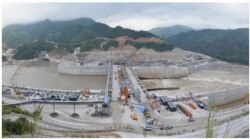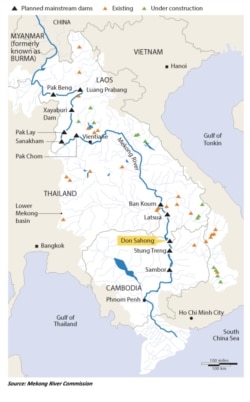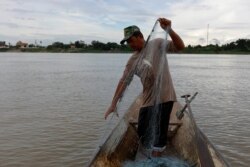Critics of the 1,285-megawatt Xayaburi hydropower dam in northern Laos fear recent upgrades to the controversial project won't be enough to save the Mekong River from a critical tipping point when it starts churning out electricity at full throttle next month.
After seven years of construction, it will be the first of 11 dams planned for the river south of China — which has built 11 dams across the Mekong already — to go online.
Some 50 million people downstream rely for a living on the river's waters, along with the fish and sediment it washes their way. Researchers and environmental advocates say the dam could block both.
"With this year's drought and the contribution to lower river levels from the cumulative effects of upstream dams holding back water, I think that the so-called ecological tipping point of the Mekong might have already arrived; if not, it's certainly fast approaching," Brian Eyler, a senior fellow at the Washington-based Stimson Center who heads the research group's Mekong Policy Project, told VOA.
"That means that the cumulative effects of these dams are creating processes that ultimately reduce the mightiness of the Mekong to a river that is harnessed and entirely managed, and therefore the natural properties of what the Mekong provides are stunted or potentially erased," he said.
The river runs more than 4,000 kilometers from China's Tibetan plateau through Myanmar,Thailand, Laos, Cambodia and Vietnam to the South China Sea.
In June, the Mekong River Commission, a multinational body monitoring the river, reported one of the lowest water levels on record. At the same time, in the middle of the region's rainy season, Thailand's northeast suffered its worst drought in a decade..
The Xayaburi's Thai operator, CK Power, denied concerns from community groups and the Thai government itself that tests it was running on the dam at the time were holding back water. The project's critics concede that low rainfall contributed to the drought but insist the dam played an important part.
"The evidence is there," said Pianporn Deetes, Thailand campaign director for International Rivers, which advocates for sustainable river management.
"The level of the Mekong cannot be dropped by one or two meters within a day like that in natural conditions," she said.
To assuage critics' fears, the Lao government and the dam's developer, Xayaburi Power, redesigned parts of the project. Xayaburi Power managing director Thanawat Trivisavet told the Bangkok Post in July that it had "applied the best technology in the world" and spent $633 million on new fish ladders alone to help fish swimming upstream get past the dam.
The MRC secretariat, after reviewing the redesign, said in January that the changes were likely to help, but added that it could not tell by how much because the company had not shared enough data or documents.
Eyler said the gates built into the dam to let river sediment through could work in theory. But the more they stay open, the less power the dam can generate. He was doubtful the Xayaburi could generate enough power to sell the amount of electricity it has promised Thailand, its main customer, and also let enough sediment pass to keep the Mekong basin properly replenished.
As for the upgraded fish passages, he said they were modeled on rivers with lower migrating fish volumes and may or may not be able to handle the larger numbers that typically swim through the site of the Xayaburi.
"It's so tragic that the fate of these downstream countries are essentially left to the role of the dice on whether these untested mitigation efforts will work," Eyler said.
Short of scrapping the project, he said the developers could have tempered the risks by building the dam farther upstream, where it would block fewer migrating fish, or along a tributary, where, if designed right, it could deliver just as much power.
"But that type of thinking is not currently being put into place in Lao or in the rest of the Mekong basin, and that's why the Mekong is dying the death of a thousand cuts by having these dams go up," Eyler said.
He also sees cause for hope, though.
Keo Rattanak, the head of Cambodia's main electricity supplier, EDC, recently set a target to source 20 percent of its power from solar energy, and said he did not foresee two dams on the drawing board for the country's own stretch of the Mekong moving forward. Thailand, as the main hydropower customer for both Laos and Myanmar, has also been talking of cutting back on energy imports in favor of developing other renewables itself.
Pianporn of International Rivers said that in some months Thailand already has twice as much installed power capacity as it uses.
"So we have to go back to the energy discussion, not 'build or not to build the dam,' but what do we actually need?" she said. If the answers power companies and policymakers continue coming up with involve the Mekong, she added, "it will be a river no more."
Xayaburi Power and Ch Karnchang, the Thai company that built the dam, did not reply to multiple requests for an interview. Lao government officials at the ministries of energy and natural resources could not be reached for comment.










